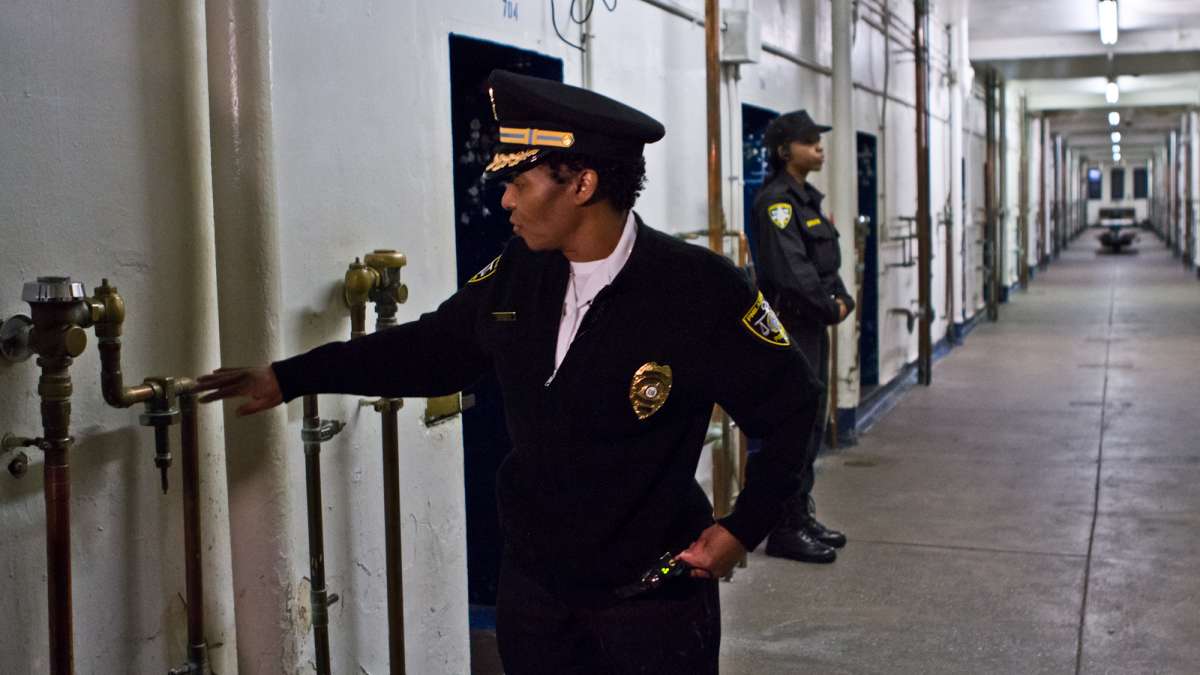Philly’s House of Correction in state of decay [photos]
-

-

-

-

-

-

-

-

-

-

-

-

Commissioner Blanche Carney speaks to the media on Thursday afternoon. (Kimberly Paynter/WHYY)
-

-

Maybe it should be renamed the House of Mouse. Or the House of Contamination?
Philadelphia prisons officials held a show-and-tell, of sorts, at the House of Correction Thursday, inviting reporters to tour the 89-year-old prison — the oldest of the city’s six prisons — to demonstrate how decrepit it has become.
The prison, which now houses more than 1,050 low- and medium-security, mostly pre-trial inmates, was built in 1927 with bricks and other materials reused from its razed 53-year-old predecessor.
And during the media tour, the old jail looked every bit its age, with peeling paint and plaster, mouse traps galore, stuffy air that went from warm to sauna-like due to inadequate heating and cooling systems, and copper pipes and duct work retrofitted awkwardly throughout the prison.
Because of the prison’s outdated, cramped conditions, prisons Commissioner Blanche Carney said, staff doesn’t have adequate space to run all the literacy, job-skills and other rehabilitative programs inmates need for successful reentry.
“We’re really limited in expanding programs and services,” Carney said.
Philly prisons officials are assessing jail conditions systemwide as part of a three-year effort, funded by a $3.5 million grant from the MacArthur Foundation, to cut its 7,500-inmate population by more than a third.
“We are looking at significantly reducing our jail population, focusing on pre-trial inmates. However, there will be some inmates who will remain incarcerated, and it is important that they are incarcerated in a facility that best prepares them for reentry into the community,” said Julie Wertheimer, chief of staff to the deputy managing director for criminal justice. “That means having more space for programs and services.”
Officials now are eyeballing ways to get the House of Correction’s inmates the programs they need, Carney said.
Mothballing the House of Correction and building a new prison has been on the to-do lists of plenty of past city leaders. But Carney, who took over the top prisons post in April, said she doesn’t know whether replacing the new prison is a priority for current city leaders.
It’s not, mayoral spokeswoman Lauren Hitt said.
“There are some limitations with HOC, especially as it relates to our MacArthur efforts,” Hitt said. “It just doesn’t have the space to do as much rehabilitative programming as we’d like. Specifically, the classrooms and triage areas are a fraction of the size of the modern institutions, and there is virtually no industrial training space. As the Mayor stated during the campaign, his primary interest is not to build an entirely new prison but instead to focus on how we can increase space for rehabilitative programming and job training, so we’re in the process of exploring those options now.”
Still, Hitt added: “Even if we met all our MacArthur goals, we still couldn’t close HOC – we would still have an inmate housing need.”
Kenney toured the House of Correction in May, telling reporters later: “I wouldn’t call [the House of Correction] dilapidated, but it’s old and needs not to be used for a prison anymore. We’re trying to figure out a way with the MacArthur Grant to get through our situation and reduce this population so that this building can be put away as a part of history. But it is clean and it is maintained by staff as best they can, but again, it’s a 100-year-old building and we need to empty it out and not replace it.”
Lawyers have sued over prison crowding in Philly, which has the highest incarceration rate of the nation’s 10 largest cities.
WHYY is your source for fact-based, in-depth journalism and information. As a nonprofit organization, we rely on financial support from readers like you. Please give today.




